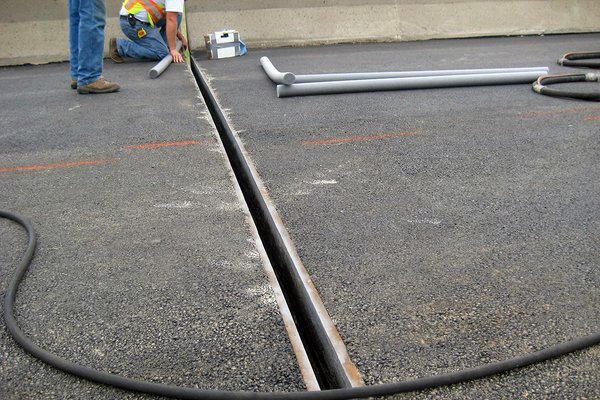
(+91) 82706 58519
Customer Care Number
info@technychemy.in
Email address
Tiruchirapalli, IN
Address location
Customer Care Number
Email address
Address location


Expansion joints are structural components designed to absorb and accommodate movement in buildings and other structures. These joints are placed between sections of concrete, steel, or masonry to allow for the natural expansion and contraction that occurs due to temperature variations, seismic forces, or other environmental factors. By allowing controlled movement, expansion joints prevent cracks, leaks, and other forms of structural damage, ensuring the longevity and safety of the structure.

Techny Chemy offers a wide range of expansion joint solutions, each tailored to meet the specific demands of different construction projects:
These joints are used in concrete slabs, pavements, and floors to allow for thermal expansion and contraction, preventing cracks and structural stress.
Designed to accommodate the significant movement that occurs in bridges due to traffic loads, temperature changes, and seismic activity, ensuring the safety and longevity of the structure.
Installed in large buildings, these joints allow for movement between different sections, preventing cracks and damage in walls, floors, and ceilings.
These are used in brick, stone, or block constructions to absorb movement caused by thermal expansion or settling, preventing cracks and mortar failure.
Specially designed joints that allow buildings and infrastructure to move and flex during an earthquake, minimizing structural damage and ensuring safety.

Expansion joints are crucial in various special applications, including:
High-Rise Buildings
Expansion joints allow for the differential movement between different parts of a tall building, accommodating thermal expansion, wind loads, and settling.
Bridges and Overpasses
These structures experience significant movement due to traffic loads and temperature fluctuations; expansion joints ensure they remain safe and functional.
Industrial Facilities
In environments with heavy machinery, temperature variations, or chemical exposure, expansion joints prevent structural stress and damage.
Tunnels and Subways
Expansion joints in underground structures accommodate movement caused by seismic activity, ground settlement, and temperature changes, preventing cracks and leaks.
Airport Runways and Pavements
These surfaces are subject to extreme temperature variations and heavy loads; expansion joints ensure they remain intact and safe for use.
Expansion joints work is essential across multiple industries, including:
Ensuring the longevity and safety of residential, commercial, and industrial buildings.
Providing critical movement accommodation in bridges, tunnels, highways, and other infrastructure projects.
Protecting pipelines, storage tanks, and other structures from thermal expansion and ground movement.
Ensuring the durability and safety of airport runways, hangars, and related infrastructure.
Accommodating movement in docks, piers, and offshore platforms exposed to varying temperatures and water levels.
By absorbing and accommodating movement, expansion joints prevent cracks, leaks, and other forms of damage that could compromise the integrity of the structure.
Properly installed expansion joints ensure that buildings, bridges, and other structures can withstand environmental stresses over time, extending their lifespan.
Expansion joints reduce the risk of structural failure due to temperature changes, seismic activity, or settling, ensuring the safety of the occupants and users.
Suitable for a wide range of materials and structures, including concrete, steel, masonry, and composite constructions.
Modern expansion joint systems are designed to blend seamlessly with the architecture, providing both functionality and visual appeal.

With over three decades of experience, Techny Chemy is a trusted leader in the construction chemical industry. Our expansion joint solutions are developed through rigorous research and testing, ensuring they meet the highest standards of performance and reliability. We offer customized solutions to meet the specific needs of your projects, backed by our commitment to innovation, quality, and customer satisfaction.
Choose Techny Chemy for expansion joints work that ensures flexibility, durability, and safety in your construction projects. Trust in our expertise to deliver solutions that stand the test of time, protecting your investment and ensuring the success of your projects.
With 30 years of experience in the chemical industry, our team of experts is equipped to offer customized solutions tailored to your specific needs.
We are committed to sustainability, offering eco-friendly solutions that are safe for both the environment and users.
Our solutions are formulated using cutting-edge technology to provide maximum protection against water and moisture infiltration.
Expansion joints are designed to allow movement in structures caused by thermal expansion, contraction, seismic activity, or settling. They prevent cracks, warping, and structural damage by accommodating these movements, ensuring the integrity and longevity of the structure.
Expansion joints are used in a variety of structures, including bridges, buildings (particularly high-rise structures), pavements, tunnels, and parking decks. They are essential wherever there is a need to accommodate movement between different sections of a structure.
Common materials include rubber, silicone, metal, and composite materials. These materials are chosen for their flexibility, durability, and ability to accommodate the specific types of movement expected in the structure.
By allowing controlled movement, expansion joints prevent the uncontrolled cracking and structural damage that can compromise a building’s safety. They reduce the risk of failure in key structural components, especially in areas subject to seismic activity or significant temperature changes.
Expansion joints should be inspected regularly for signs of wear, damage, or debris buildup that could hinder their movement. Maintenance may include cleaning, repairing damaged materials, and ensuring the joint remains flexible and functional. Inspections are typically recommended annually or after significant weather events or seismic activity.
Yes, expansion joints can be retrofitted into existing structures, especially if the building is showing signs of stress or cracking due to lack of movement accommodation. Retrofitting expansion joints can help prevent further damage and extend the lifespan of the structure.
Without expansion joints, structures can suffer from cracks, leaks, warping, and even structural failure due to the inability to accommodate movement. This can lead to costly repairs, safety hazards, and a reduced lifespan for the building or infrastructure.
The placement and number of expansion joints are determined by factors such as the size and shape of the structure, the materials used, the expected range of temperature fluctuations, and any anticipated seismic activity. Engineering analysis and building codes guide these decisions to ensure that the joints effectively manage movement throughout the structure.